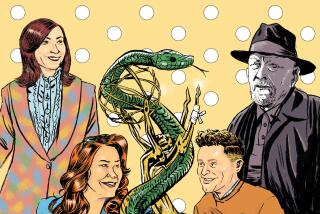Researchers Probe TV Viewers’ Minds
- Share via
For years, poets and accountants have had us believing that April is the cruelest month. Maybe in the real world that’s true, but in the life-and-death world of television, cruel can be any month that ends with a cancellation.
Here we are a few weeks into the new season and several new series have been scuttled or relocated while others seem to flourish. The sometimes-science of market research is one tool used by networks in determining the life or death of much of what we see.
How much do we really know about this research and how it’s done and how it influences what so many of us watch?
In the offices of Robert A. Brilliant Inc., a one-of-a-kind operation little-known outside a close circle of television friends, we can begin to get some idea of the process used in judging broadcast shows.
All television networks have research departments and outside consultants to gather numbers on what people like and dislike. But Brilliant, a 20-year CBS veteran, has an exclusive deal with his former network to do market research, analyze audience reactions and suggest first-aid for troubled entertainment shows. He does the same for independent television and film producers. A conversation with him is like taking a first course in the Art of Television Decision Making, without revealing any proprietary secrets, of course.
Brilliant’s technique: He counts the beans, then tries to find what the beans mean. Regularly, Brilliant’s operatives gather representative samples of the American population and place them in front of screens. Research tells them who to look for, how many women, how many men, how many professionals, etc. The audiences also have a set of buttons to indicate their reactions. Red is a “don’t like,” green is a favorable vote.
From there, the collection of responses go through computers for compilation. Then all the numbers are dropped on Brilliant’s desk for him and his staff of television veterans to evaluate.
It’s not just a matter of counting how many people don’t like a certain character. More importantly, what they are looking for is what to do to make that character lovable or plausible or acceptable. From there, extensive reports are put together interpreting and analyzing the data, information that goes to the CBS executives for their final decisions.
For CBS this season, some of their program strategies seem to be working favorably. The network is like the two World Series teams it covered: going so far from worst to first.
A small sample of how the network process works: The one-hour show was a mid-season replacement and its ratings were as weak as its future. Researchers determined that the characters and the stories seemed undefined, a sort of video gray mass. What to do? Keep the show on, but make the bad guys unarguably bad and turn one into a role model for b-a-d, but spelled J.R.
Network research into what audiences like or don’t like predates commercial television. It started more than 50 years ago when the head of CBS Radio, Frank Stanton, ordered up some studies of the network’s audience.
Applied later to network television with its once exclusive and large audiences, research became a major tool in determining what the American viewing public would watch. The task took on new meaning in the late ‘80s as the three networks saw newcomers moving into their exclusive club: a new network, cable companies, home videos, satellite dishes. At the same time, the cost of making television shows zoomed and failure became just another way to reach bankruptcy court.
The real challenge in television programming rests in developing successful pilots and new shows. Series that have seen a season or two generally have learned tricks of survival. The players are known, the situations are established, the jokes are so very familiar.
Then comes a season like the current one where half-hour shows fill up and dominate nighttime schedules. Twenty-eight TV babes started life this September, all crying for nurturing.
“Nobody wants to put on a show and let it fail,” says Brilliant. “We start with the scripts and study how the show will work. Then we test the pilots and continue testing and analyzing through the life of the show. But the bottom line is what you do with all the data. Who is able to analyze it and give it direction?”
The pilot didn’t work so it was abandoned and a new one was tried. It tested better. More reports, more suggestions. More changes. Scores began to brighten. The original title, “Vintage Years,” was dropped. In its place, “Falcon Crest.” Bingo!
Earlier this year, Brilliant again geared up his operations and went looking for people who knew something about television. That’s one key in the pursuit of ratings. He advertised for television analysts and writers this way: “The ONLY candidates to be considered are those who have TV/film reviewing and/or story analyst experience, have professional writing experience (10 publications minimum), have professional manuscript editing experience. . . .”
Experienced insiders are necessary because of what takes place after all of the usual audience research has been done.
“Computers have made our job easier. What used to take seven months to do now takes seven days. But it’s never easy,” Brilliant says. “Measuring the reactions to a show is easy. The difficult thing is to evaluate how a pilot will work as a series or how each episode will work. We interpret the data. We have to understand a show and what it will take to make it successful. We don’t just relay a score to someone else. The research has to go into a big mix. We make our suggestions based on our experiences and then they go to the network people and the creative people and they take it from there. . . .
“What we are always looking for in scripts, pilots and continuing shows is entertainment. Will the viewers be entertained? What are the components, the pieces of the show, the situations and how they are executed?
“Television shows are really no different from anything else in life. They get better with experience.”
The audience research signaled strong for the new half-hour comedy series but there was a concern whether one role would be seen as believable. Research kept coming up smiling, so Elden Bernecky keeps on painting Murphy Brown’s place.
More to Read
The biggest entertainment stories
Get our big stories about Hollywood, film, television, music, arts, culture and more right in your inbox as soon as they publish.
You may occasionally receive promotional content from the Los Angeles Times.










